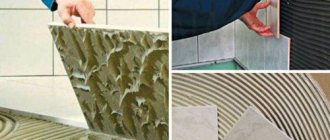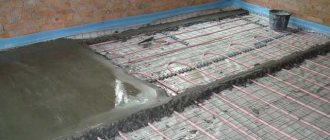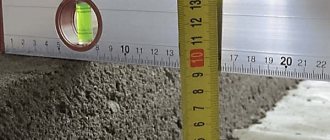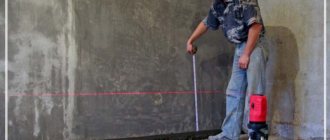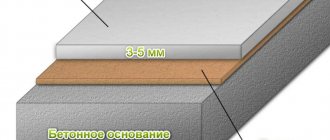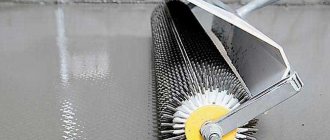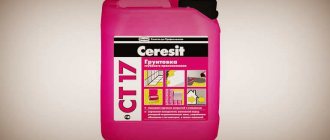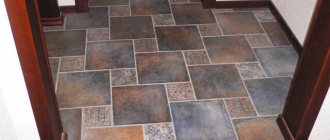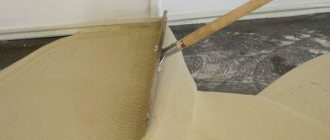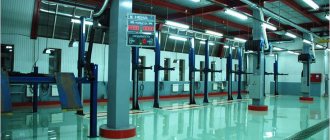The finishing floor covering is installed on a carefully prepared base. A leveling screed is laid on top of the floor slab, which after drying forms a smooth surface. However, the material shrinks, which significantly affects the quality of preparation. The curvature of the rough structure is compensated by the installation of a special material - a self-leveling self-leveling floor, the thickness of which is regulated by regulatory requirements and the manufacturer.
Self-leveling floor in the room
What does thickness depend on?
There are parameters on which the thickness of the future layer of self-leveling floor will fully depend:
- Leveling the subfloor, its level, height.
- Mechanical load during operation. The stress coefficient is very important here: vibration, surface wear resistance, external mechanical impact, shock.
- Possibility of installing a maximum thin layer. At the same time, it must correspond to the binding material.
If the self-leveling floor layer is less than the required value and does not reach the optimal parameter, then it will not last long. Performance characteristics will put pressure on it and defects and errors will immediately begin to appear. In this case, a very large layer of fill will not give a very positive result, but will only waste extra money from the budget.
Differences in floor level
Floor type
Manufacturers offer mixtures for different types of surfaces:
- simple self-leveling floors. Designed for screeds made of concrete, anhydride, reinforced concrete or monolithic slabs;
- levelers. Applied to substrates made of expanded clay, gravel, soil, wood, gypsum fiber board, plywood, linoleum, carpet and chipboard.
The packaging container indicates how to properly use the solution, what accompanying materials will be required before applying it (primer, repair mixtures, etc.).
Types of coatings
There are a huge number of mixtures used for self-leveling floors. At the same time, they have completely different thicknesses, which are necessary for laying a high-quality coating. Among them are:
- Thin-layer. The layer thickness does not exceed 5 mm. The main function of such a floor is to protect the base from environmental factors. Its quantity will depend on the type of mixture, manufacturer, and quality obtained. If you add a little more and make the consistency higher, the strength will increase slightly.
- Self-leveling. Such a layer can reach a height of 20 mm. It has excellent antistatic properties and can easily cope with numerous mechanical loads.
- Highly filled. It cannot be laid in a layer less than 20 mm. The composition of such mixtures most often includes quartz sand, magnesite, expanded clay, etc. This somewhat reduces the cost of the finished mixture for diluting the solution.
conclusions
If you want to install a self-leveling floor yourself, do not forget about such an important indicator as thickness. It must be selected in accordance with:
- type of room;
- level of mechanical load;
- quality of rough foundation preparation;
- thickness of the final protective layer;
- a type of dry bulk mixture.
If you listen to these tips when choosing building materials, the laid floor will definitely be of high quality and durable.
Thickness depending on composition
Depending on the material used during installation, the thickness of the surface also varies. So before purchasing such a mixture, you should study its characteristics, purpose and properties.
- The polymer coating has an optimal thickness of 40 mm. But no manufacturer ever recommends making a self-leveling floor from such a mixture less than 25 mm. A reduction can only occur if the surface is subsequently painted. But the reduction should not be more than 0.3 mm.
- Methyl methacrylate. The basis for it is a concrete or steel surface. The average thickness of 6 mm can withstand a load reaching a mass of 15 tons.
Optimal thickness of self-leveling floor - The cement-polymer composition is used when installing self-leveling floors on wood or ceramics. Its adhesion to the surface is excellent, and the thickness can reach up to 50 mm without loss of qualities and functions.
- Low temperature rooms. Such mixtures are based on methyl methacrylic resins, which also include anti-frost components. The maximum thickness in any case should not exceed 7 mm.
- Acrylic-cement. This is a classic option for pouring a self-leveling floor. Average thickness values are in the range of 10-20 mm. After installation, the surface can withstand mechanical loads and also easily resists various chemicals.
If the load in the room is significant, then the layer should not be less than 10 mm. This should be taken into account when choosing a specific mixture option for work.
In addition, there are mixtures for wet rooms. In addition to the constant presence of water, the floor surface can be constantly washed with water. The acrylic-cement mixture does not form any seams, and it remains hygienic and does not require leveling the surface before pouring.
Fill rules
When pouring a self-leveling floor, you should adhere to certain rules, which neither a professional in this area nor a beginner can do without. This will help to avoid problems during installation and during surface operation. Each mistake takes not only time and effort, but also large financial resources.
Before pouring a polyurethane self-leveling floor, you should wait at least 12 hours after carrying out preparatory activities. The primer must dry thoroughly. In contrast, epoxy resins require a longer drying time for the base - at least 18 hours.
Almost few people prepare the finished solution in one container at once. In this case, you should take into account the proportions of adding water so that you do not get a different mixture in the same room. Their properties and strength characteristics will differ, and the adhesion will not be uniform. After the self-leveling floor has been poured in parts, the entire solution must be distributed over the surface of the room. To do this, use a metal strip. If it is difficult to reach certain places, you can use a roller.
While mixing the solution, bubbles form in it. They also remain when poured indoors. To get rid of them, use an aeration roller. Depending on the thickness of the self-leveling floor, the length of the spikes on the roller will also differ.
Layers of self-leveling floor and base
Initially, the base layer is poured, and only after a certain time - the finishing coat. The principle and technology of the device are no different. The main difference is the thickness of the self-leveling floor, which in the latter case is only a few millimeters. So that after installation of the floor the surface remains shiny and can last for a long time, it is coated with a special varnish.
The technology for pouring a self-leveling floor with your own hands is very simple and will be understandable to a novice builder. It is important to comply with all requirements and pay attention to the nuances. This is useful not only when performing work independently, but when exercising control over a team of specialists.
Preparing the base
Preparation for each type of flooring is slightly different, but there are general procedures for all types of flooring. The first requirement concerns the mandatory repair of the old coating so that there are no peeling areas, cracks, dips, or contaminated areas. Oily bases are cleaned down to the layer where there is no fat at all.
- the projections are knocked down to the planning level;
- repair cracks with cement or gypsum mortar;
- remove dust using a vacuum cleaner;
- prime the area twice;
- install a damper tape around the perimeter and a waterproofing membrane before the second primer.
Floorboards are nailed onto a wooden base to achieve a stable state, and sometimes boards or joists are replaced. For screeds with a height of more than 10 cm, fiberglass mesh must be used for reinforcement.
Subtle technologies
Before you make a self-leveling floor, you should focus on its specific version. At the same time, everyone should understand that every millimeter is significant. Polymer coatings have especially advanced in this direction, where even 1-2 mm will be enough to withstand certain surface loads. True, not everyone can make such a thin layer efficiently. There will even be small recesses in the screed where the solution for the self-leveling floor falls.
In this case, it is important to know how self-leveling floors are made. After all, a thin layer is typical for a finishing coating. When it exists, there will be some intermediate ones. It is the base layer that will smooth out all the unevenness of the concrete or cement screed and the base itself. These mixtures are also not expensive due to their unique composition: gypsum, sand, cement, plasticizers. Polymers are almost completely absent, and if they are present in small amounts, it is only to impart strength to the surface.
The maximum thickness of the self-leveling floor, or rather the base layer, can reach 80 mm. If the mixture also contained polymers, then their final price would be exorbitant. If you have to make an even larger screed, then it is best to fill it with other components, such as expanded clay, and only then proceed further. Cheapness also encourages their replacement with semi-dry screeds. The surface becomes very smooth and can be used under any floor covering. Base layers cannot be used as a finishing coat, as they wear out very easily and are less durable in use.
Work can be carried out using quick-hardening mixtures. In this case, special attention is paid to beacons and their placement. If this is not controlled, then the thickness parameters from the manufacturer will be violated.
Rough-type self-leveling floors
Photo: rough-type self-leveling floor
The construction market has a good selection of mixtures for rough-filling floors. The main advantage is that they allow you to create thick layers to eliminate unevenness and defects in the base. Recommended for rooms with increased floor load.
Cement-based base compositions
Basic mixtures are used for preliminary leveling of floors with pronounced unevenness and height differences. Suitable for indoor and outdoor use. The presence of coarse sand (or other mineral component) up to 2 mm in the mixture gives the surface roughness. The solution has a thick consistency, but is quite elastic, reminiscent of the plasticity of a screed. Such levelers are characterized by low spreadability, so they require spreading with a spatula. Recommended layer thickness is 10-100 mm.
Complex compositions universal
For preliminary and final leveling, compositions based on cement, gypsum and cement-gypsum are used. Suitable for residential and industrial premises with normal and high humidity, with loose, insufficiently durable or low-quality floors. Universal mixtures are easy and quick to apply, so even a beginner can handle them.
Contain sand fraction no more than 1.5 mm. After preparation, the solution looks like liquid sour cream, spreads well over the surface, and therefore does not require additional leveling with a rule or spatula. Acceptable application thickness is 1-100 mm.
Optimal layer
Despite the high cost of self-leveling polymer floors, they require a minimum thickness. Optimal compositions sometimes reach only a few millimeters, such as polyurethane compositions. On top of this you can even apply the composition together with colorant, with a thickness of no more than 0.3 mm. Even adding shine and beauty to the surface does not take up much space on the entire surface.
Layers of self-leveling floor
No one makes such floors larger than five millimeters, since all the characteristics still remain at the same level. Only money goes down the drain. Such thickness parameters are also typical for epoxy compounds. However, if you want to paint such a surface, then the layer should be large due to the high fragility of the epoxy.
Methyl methacrylate compounds dry quickly and can be applied in a layer of 1 mm. This height will be sufficient for minimal loads. When the mixture is based on cement, the optimal layer will be 8 mm.
High loads
Experts can answer what thickness of self-leveling floor can be poured. At the same time, they all insist that self-leveling floors with a large screed thickness should not be used. In this case, it is best to use special mixtures that can even out differences in height. The qualities of the mixture will vary depending on the manufacturer. This is worth considering carefully. Such compositions cannot be used as a finishing coating due to their low strength characteristics.
A very large layer of self-leveling floor mortar that exceeds the optimal values will harden for a long time. During this time, it is problematic to create favorable climatic conditions for drying: indoor air humidity, temperature, absence of drafts, etc.
If you cannot do without a thick layer, then you should do the work in parts: pour one layer, and after it dries, proceed to the second.
Classification of mixtures
Self-leveling compounds are divided into two main groups:
- for rough leveling of surfaces with gross defects, height differences, cracks or cavities;
- for the installation of a decorative finishing coating on smooth bases of a high degree of readiness.
The product formulation takes into account working conditions and requirements for surface quality. The binding base is mineral substances or polymer compounds. Fillers - clean sand, fly ash, expanded clay. Modifying additives provide additional beneficial properties. The composition of the mixtures, numbering up to 15 components, is kept secret by manufacturers.
Thickness at low temperatures
If you want to make a self-leveling floor yourself, step-by-step instructions will help you do this. But it is important to look at individual cases of work, such as in the case of constant low temperatures. It is very important to choose the appropriate mixture for the job, which is based on methyl methacrylate resins. They also contain special components that help resist frost. In order for the self-leveling floor to actively withstand low temperatures, its thickness should be within 5-7 mm, no less. Refrigerators are an excellent option for installing such a floor.

